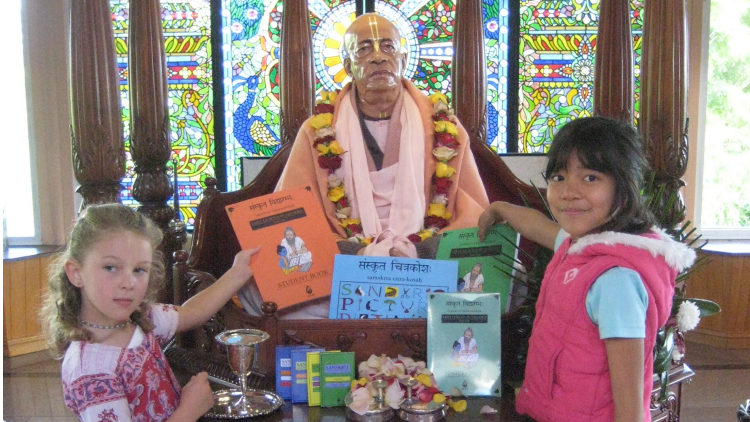Goloka Education Releases Sanskrit Curriculum for Primary Schools
By Madhava Smullen | Авг 23, 2013

Goloka Education, a company established in New Zealand and now based in Mumbai, India, is just about to publish the second printing of its Samskrta Vidyarambhah Part 1, the first volume in its new Sanskrit Curriculum for primary schools. The company previously released its Samsrkta Citra Kosah, an accompanying Sanskrit picture dictionary, in December.
Established last year on April 24th on the auspicious day of Akshaya Tritiya, Goloka Education aims to develop cutting edge educational resources based on Vaishnava and Vedic teachings. It also develops teacher training programs and helps ISKCON schools and other international schools in their policy, implementation, and set-up.
“We feel like there’s a bit of an educational explosion happening in ISKCON,” says Prana Das, co-director along with Ramgiridhari Das. “And we want to help support devotees by providing resources and knowledge so that they can open up schools.”

Author Prana Das with his Sanskrita Vidyarambah (First Lessons in Sanskrit)
Goloka Education’s introductory Sanskrit course, beginning with its Samskrta Citra Kosah and Samskrta Vidyarambhah Part 1, has been one of the major developments so far and has been well received.
The course focuses on Sanskrit language communication rather than grammar, and essentially teaches Sanskrit as a second language in much the same way as public schools might teach French or Spanish.
In Part 1 of the course, children will learn to introduce and express themselves, and communicate their feelings and ideas in simple language. The approach uses high frequency and common themes, so they’ll learn about food, colors, people, places and things they can find in their classroom environment and home.
“It’s done in a fun, interactive way, through games and different tasks,” Prana Das says. “So they’ll learn the language not by rote but in a natural and authentic way. Also, we think most ISKCON schools are going to be interested in taking it up, because it’s a very Krishna conscious course. Much of it is based on the Srimad Bhagavatam, and uses Lord Krishna and His family as subjects.”

Artist Hiranyangi Dasi with a copy of the Sanskrit Picture Dictionary
The curriculum is also very convenient as it is created not according to age but according to Sanskrit language proficiency—so it can be introduced at any grade. Even adults new to the language have expressed interest in using it to learn Sanskrit.
The ingenious system was developed and written by Prana Das, who holds a B.A. in Sanskrit from the University of Melbourne in Australia and has also studied with Samskrita Bharati in India.
Prana has also been teaching a Sanskrit course he developed himself in ISKCON schools in Australia and New Zealand since the 1980s—in fact, the current curriculum is a result of wanting to make that course available to a wider number of children.
“Srila Prabhupada said a lot of things about gurukula, some of them controversial points that not everyone can agree on,” Prana Das says. “But one thing everyone can agree on is that he said we should teach Sanskrit and we should teach the English language. Those are two curriculum areas that Prabhupada really identified. So we were going to start our Goloka Education with an English language program. But we thought it would be more valuable to present people with a really accessible approach to Sanskrit.”

Using the Sanskrit curriculum materials at the Hare Krishna School in New Zealand
With Part 1 currently being reprinted, Samskrta Vidyarambhah Part 2 will be released by the end of this year. It will continue teaching high frequency words and common themes, this time covering time, numbers, and parts of the body. It will also cover some grammar, and further give children a comprehensive capacity to communicate in a wide range of natural areas. Like Part 1, it will include a student book, teacher’s guide, and card games and posters.
So far, schools in the UK, New Zealand, Australia, and India are already using the curriculum or have placed orders for it.
It’s just the beginning for Goloka Education, which is developing a team at its Mumbai offices, and currently focusing on writing a full Krishna conscious curriculum for children aged two to six on everything from languages to music to drama. The company also plans to develop an English language course using Srila Prabhupada’s books the Srimad-Bhagavatam and Chaitanya Charitamrita.
“One of the motivations behind our company is to provide high quality resources,” says Prana. “Because a lot of ISKCON schools in the past have had to use old, photocopied, or fading resources—some not even Krishna conscious, but borrowed.”
He feels that instead, ISKCON should be providing children in its schools with the best, most colorful and appealing resources.
“We want to show our kids that we value their education, we value them as individuals, and we want to give them the very best,” he concludes.
To find out more about Goloka Education and its products and services, please visit http://golokaeducation.com/. To order its Sanskrit curriculum, please write to info@golokaeducation.com.















